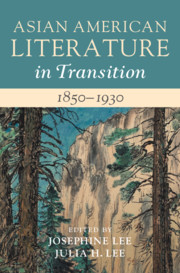Book contents
- Asian American Literature in Transition, 1850–1930
- Asian American Literature in Transition
- Asian American Literature in Transition, 1850–1930
- Copyright page
- Contents
- Illustrations
- Notes on Contributors
- Series Preface
- Introduction: Asian American Literature in Transition, 1850–1930
- Part I Empire and Resistance
- Part II Bodies at Work and Play
- Part III Crossings
- Chapter 12 Affect and Form in the Writings of the Eaton Sisters
- Chapter 13 Osato-san’sHands
- Chapter 14 Revolutionary Formalisms
- Chapter 15 Slave to Love
- Chapter 16 Anna May Wong’s Greetings to the World
- Bibliography
- Index
Chapter 15 - Slave to Love
Racial Form in Early Asian American Miscegenation Plots
from Part III - Crossings
Published online by Cambridge University Press: 27 May 2021
- Asian American Literature in Transition, 1850–1930
- Asian American Literature in Transition
- Asian American Literature in Transition, 1850–1930
- Copyright page
- Contents
- Illustrations
- Notes on Contributors
- Series Preface
- Introduction: Asian American Literature in Transition, 1850–1930
- Part I Empire and Resistance
- Part II Bodies at Work and Play
- Part III Crossings
- Chapter 12 Affect and Form in the Writings of the Eaton Sisters
- Chapter 13 Osato-san’sHands
- Chapter 14 Revolutionary Formalisms
- Chapter 15 Slave to Love
- Chapter 16 Anna May Wong’s Greetings to the World
- Bibliography
- Index
Summary
This chapter considers how literary representations of interracial relationships between Asians and other US racial groups underwent a major transition in the 1920s, in response to shifting geopolitics in Asia. In Mae Munro Watkins Franking’s My Chinese Marriage (1921) and W. E. B. Du Bois’s Dark Princess (1928), miscegenation plots serve to expand the possibilities for transnational alliances and to register American anxieties about social upheaval in Asia. Franking’s memoir provides an intimate look at the romance between a white American woman and a Chinese man in the USA and in China. Du Bois’s Dark Princess highlights the international revolutionary potential represented by the union of an African American man and an Asian Indian woman. These plots reject a binary choice between American or Asian identities. And yet, despite their progressive or revisionist energies, these works reveal a reliance on patriarchal, reproductive models of gender and sexuality and an erotic excess that serves both as justification for miscegenation and as fodder for critics. This chapter argues that these early twentieth-century discourses of reproductive heterosexuality and transnational, coalitional politics should be understood as an example of what Colleen Lye refers to as a distinctive Asian American “racial form.”
Keywords
- Type
- Chapter
- Information
- Asian American Literature in Transition, 1850–1930 , pp. 264 - 280Publisher: Cambridge University PressPrint publication year: 2021

